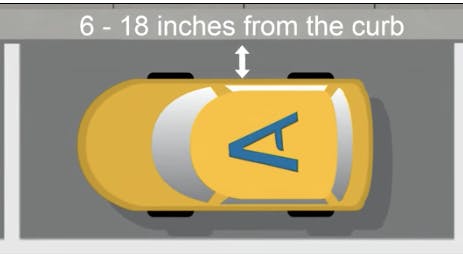15% OFF OR MORE WITH OFFER!
How to Parallel Park
4 Easy Steps To Parallel Park
Parallel parking is more intimidating to most new drivers than your typical perpendicular parking (the kind you do in most parking lots). It involves steering in reverse, precise positioning, and quite a few obstructions you could accidentally scrape. You'll need to learn parallel parking if you plan on driving in the city, and there's a good chance you'll be tested on this skill at the DMV or DPS test center when you upgrade from your permit to your drivers license. Yeah, that's right. This will likely be on your driving test. But it’s going to be okay. Like most driving techniques, parallel parking just takes some practice. Once you understand the steps, it’s pretty easy to do without tapping a rear bumper or ending up embarrassingly far from the curb. And trust us, this is one parking skill you're going to want to have.
Step 1: Claim the Spot
While you're driving, look for available parking spaces on the curb along the side of the street. The ideal parking spot will be at least one and a half times the length of your vehicle. Don’t try to squeeze into tiny spaces between other cars, especially if you’re a beginner and you don’t drive an equally tiny vehicle. Also, make sure you’re not too close to a fire hydrant, intersection, tow-away zone, etc.
Got your eye on the perfect spot? Claim it! Turn on your turn signal ASAP so that any drivers, pedestrians, or bicyclists behind you understand that you’re about to park. Using your signal is an important step, especially when there's a lot of traffic on the roads. You don't want to confuse or endanger other drivers by stopping or reversing in a lane of travel without warning them. Drive past the empty space to pull up even with the vehicle in front of the space. You will be side by side with this other parked car.
Step 2: Back It Up
Check your rear-view mirror, your side-view mirrors, and over your left shoulder again. If you have a backup camera, check that too. Once you're sure there's no oncoming traffic to get in your way, change gears to reverse. You're ready to start maneuvering into the parallel parking space. Turn your steering wheel to the right while simultaneously backing up. (Most of your parallel parking conquests will be to the right, with left side parking being reserved for one-way streets.) This will guide the rear of your vehicle at a backward angle towards the parking space.
Step 3: Turn and Stop
Once your car is at a diagonal angle, turn your wheel to the left as you continue slowly backing up. Move backward slowly and carefully as you straighten the vehicle and get into the spot. Keep your foot over the brake pedal in case you need to stop quickly. Stop when you get close to the parked vehicle behind you. You don't want to tap bumpers, and you also don't want to park so close that getting out later will be hard. A little wiggle room is always nice.
Step 4: Straighten Up
If nothing has gone horribly wrong, you should be in the parking space at this point. You will be fairly close to the vehicle behind you and have several feet of clear space in front of you. Switch gears to “Drive”. You do NOT want to accidentally drive in reverse and hit the car behind you. Pull forward and turn your steering wheel to straighten out your wheels and get centered in the parking spot. Leave several inches of space in front of your car. Park and throw that parking brake into action! Your wheels should be 6-18 inches away from the curb. Closer is better since you don’t want to block the traffic lane or get sideswiped by a passing vehicle. A couple of feet is too far. We recommend trying out your parallel parking technique in a parking lot before taking on the real world. This will give you a low-pressure chance to really get down the moves.
That’s it! You parallel parked! If you continue to practice these steps, you'll be a parallel pro in no time! Check out more of our safe driving videos to continue gaining pro status behind the wheel.

Leave 6-18 inches between your car and the curb
How Does Parallel Parking Work?
Okay! Time to delve into the science of parallel parking! We promise it's actually interesting stuff
When you first pulled up to the front car and started to turn the wheel you used the “Ackermann Steering Linkage.” This mechanism was invented in 1817 and allows your tires to circle a common point by turning the wheels at slightly different points.
Another important mechanic that allows for parallel parking is the pivot point. As you turn your the point where the axis for your front tires and the axis for your rear tires meets gets closer and closer to your car. This point is called your pivot point and is what your car circles when you are turning.
Hopefully, that's not all too confusing. If you are a visual learner the video above explains the above comments in 360 degrees!
